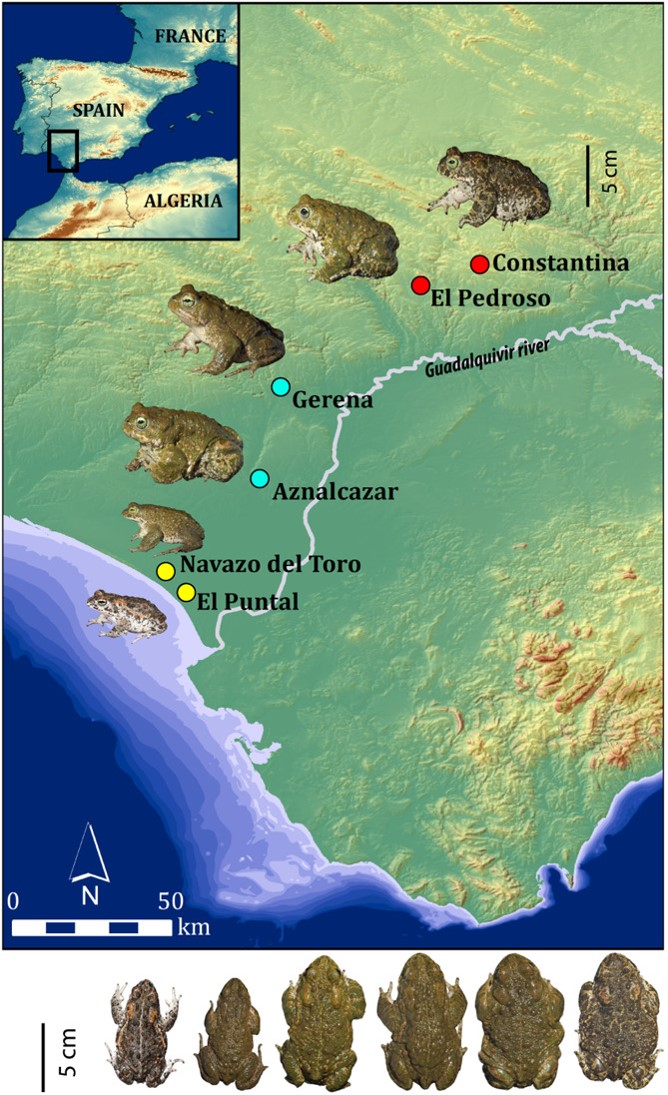Ample variation in body size is common in vertebrates over extensive geographical distances, or in isolated populations, where effective geographical barriers may cause dwarfism or gigantism. The potential causes of extreme size reduction in continental populations of amphibians within a short geographical distance and in the absence of geographical barriers were studied. Natterjack toads Epidalea calamita in Doñana National Park (Spain) experience up to 2.1?fold difference in body mass in as little as 37?km. Studying six populations divergent in body size, the genetic isolation of the dwarf populations using multilocus genotypes (16 microsatellites) was tested. Additionally, it was explored whether populations differed in trophic status (through stable isotope analysis), standard metabolic rate and growth pattern, senescence and age structure (conducting telomere length assays and skeletochronology). Advertisement calls were also recorded across populations and experimentally tested for behavioural reinforcement of the body size variation through female preferences. Local dwarfism in these populations occurs in the absence of genetic isolation while maintaining relatively high effective population sizes. Dwarf populations, however, were exposed to drier and warmer climatic conditions, have different trophic status, show lower mass?specific metabolic rate, and male advertisement calls with a higher dominant frequency. Juvenile growth differed among populations, reaching the adult stage at different body sizes. Altogether, these results suggest a significant influence of environmental conditions on the physiology and ecology of the Doñana E. calamita populations, mainly affecting toads between metamorphosis and sexual maturity. Further experimental and genomic studies focusing on these early life stages are necessary to dissect the relative roles of the environment and adaptive genetic differentiation on this phenomenon. informacion[at]ebd.csci.es: Hyeun-Ji et al (2020) Dwarfism in close continental amphibian populations despite lack of genetic isolation. OIKOS Doi 10.1111/oik.07086
https://onlinelibrary.wiley.com/doi/full/10.1111/oik.07086
Welcome
Welcome to the official website of the Doñana Biological Station (EBD-CSIC)...

The Doñana Biological Station: EBD-CSIC
The Doñana Biological Station is a public Research Institute belonging to the Spanish Council for Scientific Research CSIC in the area of Natural Resources...

Mission
Our fundamental mission is to carry out multidisciplinary research of the highest standard directed to understanding the way in which biodiversity is generated, maintained and deteriorates, as well as the consequences of its loss...

Our methods
We apply many techniques within a multidisciplinary framework, from molecular genetics to remote sensing, and from modelling to physiological and isotopic analyses...

Monitoring the environment
Monitoring biodiversity at the Doñana Natural Space cover a wide range of communities, including both terrestrial and aquatic organisms...

Aims
Our aims include the study of the ecological and evolutionary processes by combining field work, mathematical and statistical models and physiological and genetic analysis...
 Outstanding
Outstanding
Dwarfism in continental populations of natterjack toads in the absence of genetic isolation
 News
News
 Open Call for Research Projects in ICTS-Doñana!
Open Call for Research Projects in ICTS-Doñana!
 Las altas temperaturas están provocando que las lagunas y las marismas de Doñana pierdan agua rápidamente
Las altas temperaturas están provocando que las lagunas y las marismas de Doñana pierdan agua rápidamente
 Traffic noise causes lifelong harm to baby birds
Traffic noise causes lifelong harm to baby birds
 Illegal wildlife trade, a serious problem for biodiversity and human health
Illegal wildlife trade, a serious problem for biodiversity and human health
 Urbanization and loss of woody vegetation are changing key traits of arthropod communities
Urbanization and loss of woody vegetation are changing key traits of arthropod communities
The loss of woody areas is linked to a decline in the duration of the activity period, a higher tolerance to drought, and less dispersal capacity in both groups.





